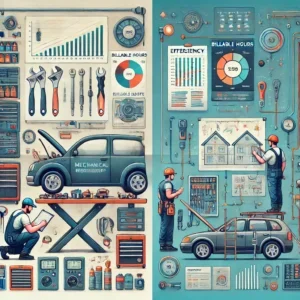
Know your numbers
One of the most common questions we get from our coaching clients is: ‘what’s the single most important step I can take to put my business on the right track?’
And our answer is always the same. ‘Know your numbers.’
Why?
Because if you can’t measure where you’ve been and where you are, you’ll never be able to figure out where you should be going.’
Think of your financials as a type of map that will guide you towards the promised land.
Begin by focusing on those parts of your business incur the greatest cost and over which you have direct control. In our experience, most of these factors will involve your staff and your stock/materials.
Metric One – Labor Productivity
One of the first things you’ll want to quantify is the productivity of your workforce. This can be calculated by dividing ordinary hours paid to staff by hours charged to customers and then multiplying by 100.
For example, if you paid staff for a 38-hour week, but billed customers for only 30 hours of work, your labour productivity is ratio is 30 ÷ 38 x 100 = 78.9. This means you have labour
productivity rate of 78.9%
Calculating this number will enable you to develop strategies for increasing your productivity rate because the higher your percentage number the more revenue bang you’re getting for your salary buck.
Metric Two – Job Profitability
Another major metric you’ll want to analyse is your gross profit (GP) of ever job. GP is calculated by subtracting the direct costs of each job from the retail price of the goods and/or services purchased by your customers.
Let’s say, for example, if you sell a product at a price of $800 per unit. The labour cost to produce that item is $300 and the materials cost $100. With this product, your GP per item
would be $800 – $300 – $100 = $400, or 50% of the price you charge to your customer.
An insufficient GP can be the result of several factors, including:
- price quotes that are too low
- unproductive staff
- supplier challenges,
- inability to obtain stock at the best rate
- site access problems
- project management inefficiencies
- inadequate structure to deliver on a type or size of job.
When your GP is higher than expected, you should also analyse your numbers to find out why. This will help you uncover ways to replicate that success.
Metric Three –Stock Turnover Rate:
Your stock turnover rate (STR) is a metric that is often overlooked by business owners. It measures the number of times your stock has ‘turned over’ – meaning has been replaced – over the course of
a single year.
The higher your STR, the less time it takes for your stock to be expended. For example, if your business turns over $2,000,000 per annum and the value of your average carried stock is $400,000,
then your STR will be $2,000,000 ÷ $400,000 = 5.
Calculating your STR will give you the tools you need to make your stock purchases more efficient. It will give you a window into when you need to order new stock and how much you need to purchase.
You’ll be able to identify which items of stock you hold are slow-moving or even obsolete. It will also give you an indication of how long it takes between the ordering and arrival of stock.
All of these factors will lower your storage costs and reduce wastage from unused stock that outlives its use-by date.
You’ll be surprised how much money you will be able to save by streamlining your stock purchasing practices. You’ll avoid tying up valuable revenue in materials that end up gathering dust on
warehouse shelves.
The Alluvion Way
Your Alluvion Business Coach will help you to identify the metrics that are important for your business. We’ll then help you to work out strategies and tactics to find, measure, and improve those
numbers.
By this tried and true methodology, Alluvion Business Coaching will put you on the path to business and personal success.
Never miss an article
Subscribe to be notified when new blog articles are posted
"*" indicates required fields




